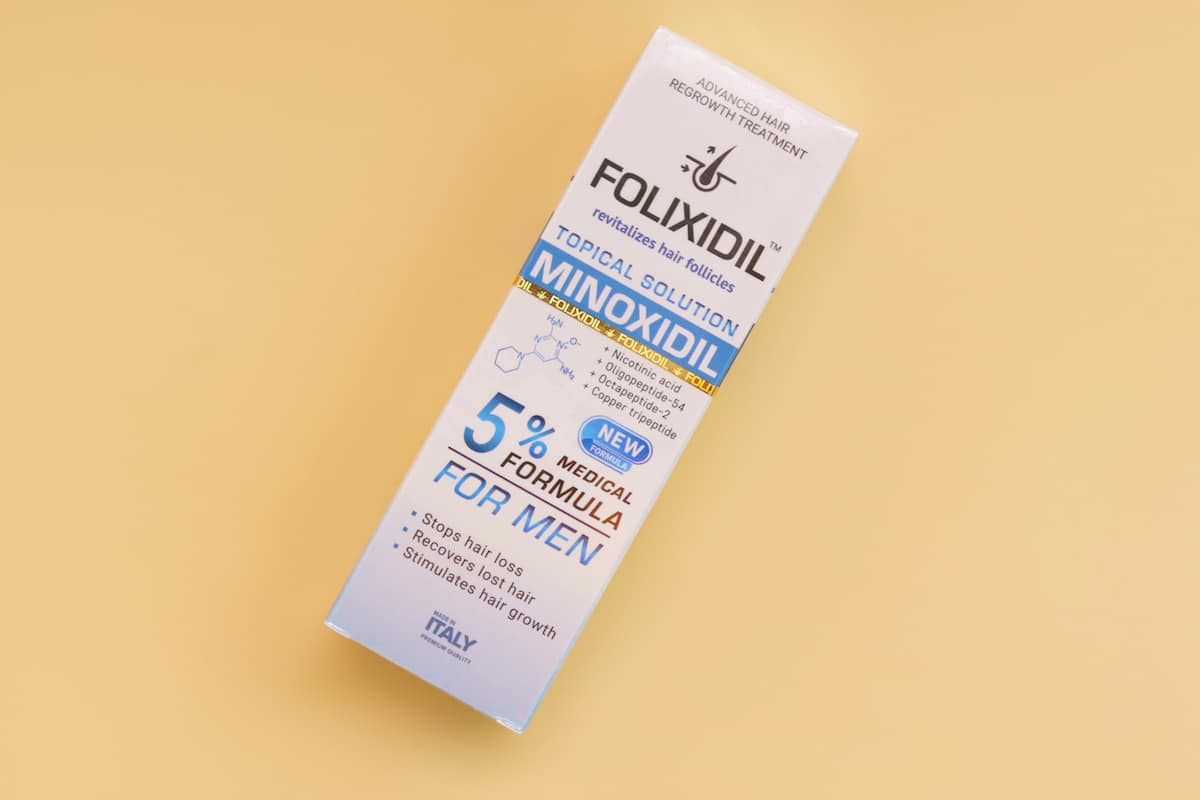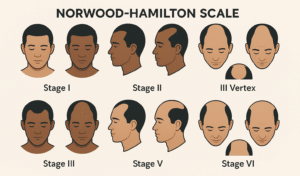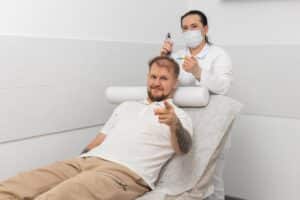DHT is an androgen responsible for male pattern baldness. In this article, we will discuss everything related to DHT: the symptoms, prevention, and treatments of DHT-related hair loss.
What is DHT?
Dihydrotestosterone or DHT is an androgen – a male sex hormone – that is being converted from testosterone by an enzyme called 5-alpha reductase. It contributes to conventionally “male” characteristics, such as body hair growth, increased muscle mass and fertility.
Travelling through the bloodstream, it binds to receptors on the hair follicles. In some men, the hair follicles are sensitive to normal amounts of DHT. Via an unknown mechanism, this causes the activation of genes responsible for the miniaturization of hair follicles and your scalp becomes less capable of promoting healthy hair growth.
As one of the most important male sex hormones, Dihydrotestosterone can also pose risks for other bodily functions.
What are the effects of DHT on the human body?
High levels of DHT can increase your risk for certain conditions such as:
- Prostate cancer
- Benign prostatic hyperplasia
- Slow healing of skin
- Coronary heart disease
Low levels of dihydrotestosterone pose increased risks in sexual development such as:
- Gynecomastia
- Increased risk of prostate tumors
- Delayed onset of puberty
Going bald: How is DHT involved?
Hair grows from tiny structures in your skin called follicles, found all over your body. A hair in a follicle usually has a lifespan of two to six years. It doesn’t matter if you shave or cut your hair; the same hair will grow back from the root of the hair inside the cell.
When this cycle is over, the hair goes into a “resting phase” and it stays there for a few months before falling out. The root then grows a new hair, and the process starts all over again.
Male sex hormones can attach to proteins called androgen receptors. This binding action usually leads to normal hormonal processes, such as hair growth on the body or facial hair growth. However, some men’s hair follicles can be more susceptible to the damaging effects of androgens due to variations in the AR gene.
If your hair follicles are sensitive to it, DHT can make them shrink and shorten this cycle. This makes your hair look thinner and more brittle as it grows out and it also falls out more quickly. This only happens for some men because their androgen receptor (AR) gene is different.
What are the symptoms of DHT-related hair loss?
The appearance and pattern of your hair can tell you if DHT affects your hair loss. The most common symptoms are:
- Receding hairline
- Thinning hair
- Norwood balding pattern
- Brittle hair
Of all the signs, the most noticeable sign is a receding hairline. If you are experiencing any of these symptoms, you may want to look at the following preventative treatments.
DHT-related hair loss: Prevention and treatment
Thankfully, there are a number of treatments available for DHT-related hair loss. Let’s have a look at the most popular and effective hair loss treatments on the market today.
Saw palmetto
Saw palmetto is a plant whose extract stops 5-alpha-reductase from working. This inhibits the conversion of testosterone into dihydrotestosterone, the hormone responsible for triggering male pattern baldness.
A recent systematic review has shown positive effects of regular saw palmetto supplementation among patients with androgenic alopecia. Saw palmetto extract is available in capsule form as a daily supplement.
Minoxidil

Minoxidil is a drug that dilates blood vessels in the skin. In other words, it helps blood arteries get wider and looser so that blood (and with it, nutrients) can flow through them more easily.
Historically, minoxidil’s primary use was in treating high blood pressure. However, researchers soon observed that patients taking the drug experienced hair growth. Subsequently, it underwent extensive study as a hair growth agent, leading to its recognition as one of two FDA-approved medications for hair loss.
The effectiveness of minoxidil varies from patient to patient. This is due to the fact that minoxidil acts as a pro-drug that is being converted into its active form, minoxidil sulfate, by an enzyme in the scalp called sulfotransferase.
This enzyme’s activity level is different from person to person and so are the results. Most users report that their hair loss has slowed down, while some start growing new hair.
Some outliers, called hyper-responders, can even go from being completely bald to having a full head of hair within a few months, but these are rare exceptions.
Minoxidil is available as a topical solution, foam, and in pill form. Better outcomes may be achieved through oral administration of minoxidil, though this approach may also elevate the risk of experiencing side effects, albeit typically mild, in comparison to topical application.
Finasteride

Finasteride is the other FDA-approved drug for hair loss. Just like saw palmetto, it works as a DHT blocker by stopping the conversion of testosterone into DHT.
Unfortunately, while it is very effective at stopping hair loss, in a small subset of patients (1-3%), the reduction of DHT includes undesirable side effects, ranging from mood changes, depression and lowered libido to erectile dysfunction and gynecomastia.
In an even smaller subset of men, these side effects can persist long after they have stopped taking the drug. This recent finding is called post-finasteride syndrome and is currently being investigated by the medical community worldwide
This is why finasteride should ideally only be considered for very aggressive hair loss and only after other effective options, such as minoxidil, have been exhausted.
Ketoconazole
Ketoconazole is a drug used to treat fungal infections, but studies have shown that it has anti-androgenetic properties and as such is effective at treating hair loss as well.
The trio of ketoconazole, minoxidil, and finasteride, referred to as the “big three,” collectively offers maximum effectiveness in treating hair loss when used together.
Medical shampoos containing 2% ketoconazole are accessible, yet they can be harsh on both the hair and scalp since their primary purpose is to combat fungal scalp infections.
Nevertheless, an increasing number of shampoos with gentle formulations, incorporating ketoconazole, are emerging in the market. Keep an eye out for these, as they are specifically crafted with the health of both hair and scalp in mind.
Hair transplant
A hair transplant in Turkey is a surgery that can be used to treat hair loss caused by dihydrotestosterone. It includes moving hair from parts of the scalp where it is still growing because the follicles are genetically resitant to the harmful effects of DHT to places where hair is falling out.
Hair transplants are the most successful way to treat hair loss caused by male pattern baldness (androgenic alopecia), but each patient may see different results.
While there are various types of hair transplant techniques, the Follicular Unit Extraction (FUE) is at the forefront. This process produces seamless results because it recreates your hairline, taking the hair grafts one at a time.
Before making a choice, you should talk to your doctor about the pros and cons of getting a hair transplant. Why not book a free consultation with Cosmedica if you want to talk about getting a hair transplant with one of our experts?
Conclusion
DHT plays a significant role in male pattern hair loss and affects other aspects of our physiology. Various treatments are available to address this issue, and a holistic approach to hair care is also crucial.
Following low-maintenance routines like taking supplements can go a long way to reverse your hair loss and bring you back to feeling like your original self. And if everything fails, you can always get an affordable price hair transplant in Turkey to restore your hair to its former glory.
FAQ
What causes DHT-related hair loss?
DHT-related hair loss occurs when dihydrotestosterone binds to hair follicles, particularly in genetically predisposed individuals. This binding can cause hair follicles to shrink, resulting in shorter growth cycles and thinning hair over time.
What are common symptoms of DHT-related hair loss?
Common symptoms include a receding hairline, thinning hair, a Norwood balding pattern, and brittle hair. Notably, a receding hairline is often the most noticeable sign of hair loss related to DHT sensitivity.
How can DHT-related hair loss be prevented or treated?
Prevention and treatment options include saw palmetto, minoxidil, finasteride, and ketoconazole. Each of these works by inhibiting DHT or promoting healthy hair growth, with various effectiveness depending on the individual.
What is a hair transplant and how does it work?
A hair transplant involves relocating hair follicles from DHT-resistant areas of the scalp to thinning areas. It focuses on restoring hair density effectively, with techniques like Follicular Unit Extraction providing natural-looking results tailored to each patient.




